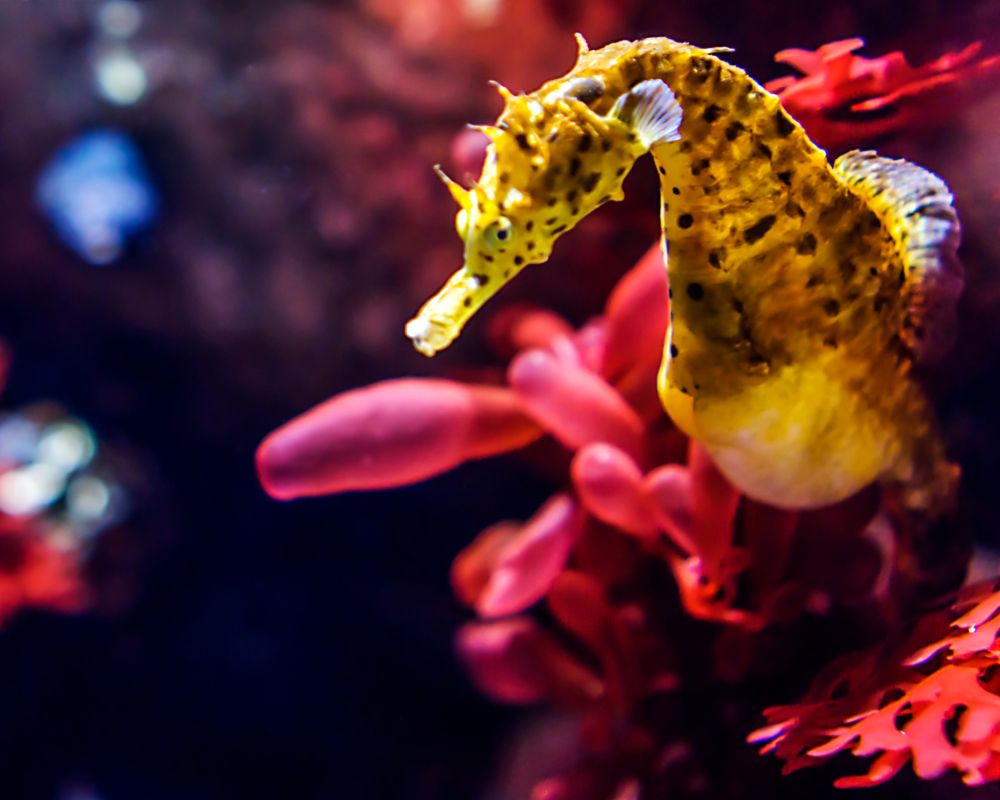These enchanting creatures have captured the imaginations of marine enthusiasts and casual observers alike with their whimsical appearance and intriguing behaviors. Today, we’re diving deep into one of the lesser-known aspects of seahorse biology – their excretory system.
While we often marvel at the vibrant colors and intricate patterns adorning their bodies, it’s equally important to understand the inner workings of these captivating creatures. In this blog post, we’ll explore how seahorses excrete waste, shedding light on their unique anatomy and the processes involved.
Anatomy and Digestive System of Seahorses

Seahorses are not your ordinary fish. They boast some truly unique features that set them apart from their underwater counterparts. So, let’s take a closer look at their anatomy and get to know these fascinating creatures a little better.
Overview Of Seahorse Anatomy: Uniqueness At Its Finest
When it comes to looks, seahorses take the prize for being the underwater fashionistas. They have elongated bodies, adorned with vibrant colors and intricate patterns that make them the envy of the ocean runway. But it’s not just their good looks that make them special; it’s their entire package.
The Digestive System: Going Beyond The Belly
Now, let’s dive into the seahorse digestive system and explore how these little marvels process their meals. Prepare to be surprised, because seahorses have a few tricks up their fins!
No Stomach? Seahorses Have Mastered The Art Of Skipping A Meal
Yep, you heard it right – seahorses don’t have a stomach! They must be the ultimate foodies who skip the whole “waiting in line at the buffet” ordeal. Instead, they have a straight shot from their snouts to their intestines. It’s like a one-way street for deliciousness!
Intestines: The Unsung Heroes Of Digestion
Without a stomach, seahorses rely heavily on their intestines for digestion. These miraculous organs work overtime to break down the food into absorbable nutrients. It’s like having a top-notch chef inside their bodies, preparing a gourmet meal on the go!
Jaws Of Fury: Specialized Equipment For Prey Capture
Seahorses have jaws that are worthy of admiration. They are uniquely designed to snatch up their prey with lightning-fast precision. Imagine having jaws so skilled that you could catch your favorite snack without even breaking a sweat. Seahorses have got it covered!
Snout Sensations: Feeding In Style
But wait, there’s more! Seahorses have long, tubular snouts that act like straws. These snouts are not just for show; they’re essential for feeding. Picture this: a seahorse stealthily approaching its prey, using its snout like a straw to suck it right up. It’s like enjoying a refreshing drink on a sunny day, but with seafood instead of soda!
Seahorse Diet and Waste Production
Now that we’ve explored the unique anatomy of seahorses, it’s time to satisfy our curiosity about their culinary preferences and how they handle waste management. Brace yourself for some fascinating facts about seahorse dining habits and their creative waste disposal methods!
Seahorse Dining Delights: Tiny Treats For Big Appetites
When it comes to mealtime, seahorses have a discerning palate. They fancy themselves as connoisseurs of the sea, with a particular penchant for small crustaceans and tiny fish. It’s like they have a secret recipe book for the most delectable underwater delicacies!
Digestion Demystified: Turning Food Into Fuel
Now, let’s pull back the curtain on the seahorse’s digestive process. It’s like being invited into the kitchen to witness the magical transformation of food into energy.
1. Food Breakdown: The Intestinal Blender
Once the seahorse gulps down its meal through its snout, the real action begins in the intestine. This is where the food is broken down into smaller, more manageable pieces. It’s like having a mini-blender inside, chopping everything up for maximum nutrient extraction!
2. Enzymes and Microbial Fermentation: Nature’s Digestive Team
Seahorses have a secret weapon in their digestion arsenal: enzymes and microbial fermentation. These tiny powerhouses help break down complex molecules into simpler ones, ensuring that every last bit of goodness is extracted from the meal. It’s like having a team of microscopic chefs working tirelessly to prepare the ultimate feast!
3 Nutrient Absorption: A One-Way Ticket to the Bloodstream
Once the nutrients are released from the food, they make their way through the intestinal walls and into the seahorse’s bloodstream. It’s like a first-class ticket to the bloodstream, ensuring that every nutrient is delivered to where it’s needed most. Talk about efficient delivery service!
The Art Of Seahorse Waste Disposal
Now, let’s address the topic that many of us are curious about – how seahorses handle waste production. It’s time to unravel the mystery behind their waste management system.
1. Intestinal Innovation: The Birthplace of Waste
The intestine plays a vital role not only in digestion but also in waste formation. As the food continues its journey, undigested matter accumulates and takes shape within the seahorse’s intestine. It’s like the creation of a mini garbage dump, where waste starts to come together.
2. Faecal Pellets: The Elegant Exit Strategy
Seahorses have a clever way of eliminating undigested matter – they transform it into fecal pellets. These compact little packages of waste are expelled from their bodies through the cloaca. It’s like a tidy exit strategy, leaving the seahorse feeling refreshed and ready for the next dining adventure!
Excretion in Seahorses
Alright, let’s dive into the intriguing world of seahorse excretion! While waste disposal may not sound like the most glamorous topic, it’s a vital process that ensures our seahorse friends stay happy and healthy.
So, buckle up and get ready for an adventure into the world of seahorse excretion!
A. The Excretory System: Kidneys And The Bladder Dream Team
First things first, let’s give a quick overview of the excretory system in seahorses. Just like us, seahorses have their very own waste management squad that keeps things running smoothly.
1. Meet the Kidneys: The Filtration Wizards
Seahorses have a pair of kidneys that are hard at work behind the scenes. These remarkable organs are responsible for filtering waste products from the bloodstream. Think of them as the ultimate cleanup crew, ensuring that only the good stuff stays in circulation.
2. The Bladder: Waste Storage Extraordinaire
But where does all that filtered waste go? Enter the urinary bladder, the seahorse’s trusty storage unit. This elastic little organ holds onto the waste until it’s time for a grand exit. It’s like having a portable waste bin tucked away for safekeeping.
B. The Process Unveiled: Filtering, Reabsorption, And Ammonia
Now, let’s uncover the step-by-step process of excretion in seahorses. Get ready to witness the intricate dance of waste management happening inside their bodies!
1. Filtering the Waste: Kidneys Take the Stage
The kidneys in seahorses play a crucial role in waste disposal. They filter out the waste products from the bloodstream, ensuring that only the good stuff remains behind. It’s like having a top-notch water purifier that keeps the blood sparkling clean!
2. Water and Ions: A Lesson in Reabsorption
As the waste products are filtered, something magical happens – the seahorse’s body reabsorbs water and essential ions. It’s like a recycling system at work, conserving precious resources and maintaining a delicate balance. Nature truly is the ultimate master of efficiency!
3. The Nitrogenous Waste
One particular waste product that seahorses excrete is ammonia. This nitrogenous waste is a result of protein breakdown. Seahorses eliminate ammonia as a means of keeping their internal environment in check. It’s like doing a little spring cleaning, making sure no unnecessary toxins stick around.
C. Waste Elimination: Bladder Storage And The Cloaca Connection
Now, let’s get down to the nitty-gritty of waste elimination from our seahorse buddies. It’s time to unravel the final steps of the waste management process.
1. Bladder Storage: Waste in the Holding Pattern
Once the waste is filtered and processed, it finds its temporary home in the urinary bladder. The bladder acts like a storage depot, holding onto the waste until the time is right for its grand exit. It’s like waiting for the perfect moment to take out the trash!
2. The Cloaca Connection: The Exit Strategy
When the time comes, waste is released through a small opening called the cloaca. The cloaca serves as a multipurpose exit, handling both waste elimination and reproduction. It’s like having a one-stop shop for all things essential – waste management and creating new seahorse generations!
Conclusion
In our journey through seahorse excretion, we’ve uncovered their unique anatomy, digestive system, and waste management strategies. From their specialized jaws to their bladder storage and cloaca exit, seahorses amaze us with their adaptability. They remind us that even the smallest creatures have fascinating mechanisms to maintain balance in their underwater world.
Let’s continue exploring the wonders of marine life, always curious and amazed by the beauty that lies beneath the waves.

Hi, I’m Ali Tarek, the founder of Animalsman. I’ve always been passionate about pets, especially dogs and cats, and I created this website to share practical tips, easy recipes, and helpful care advice for fellow pet lovers. My goal is to make pet care simple, enjoyable, and accessible for everyone. When I’m not writing or curating content, you’ll usually find me spending time with my furry friends or learning new ways to keep them happy and healthy.



